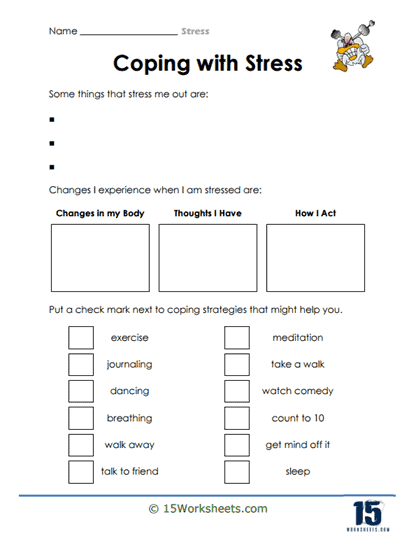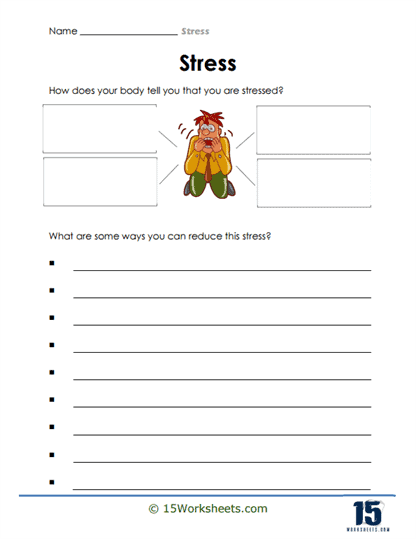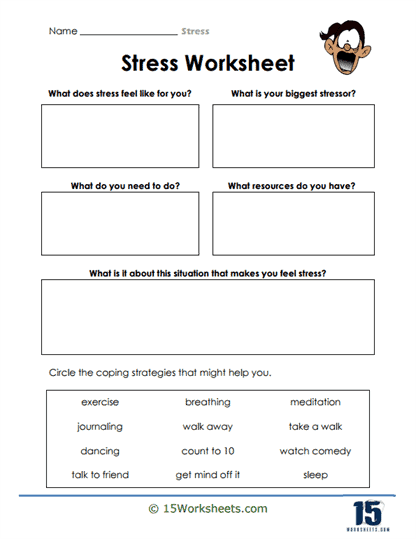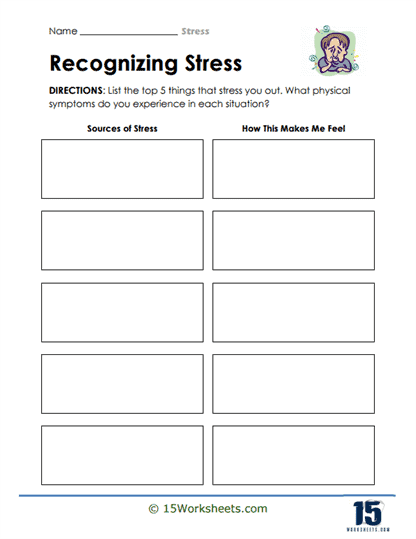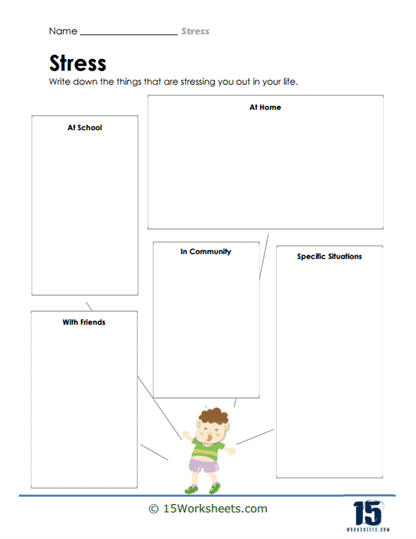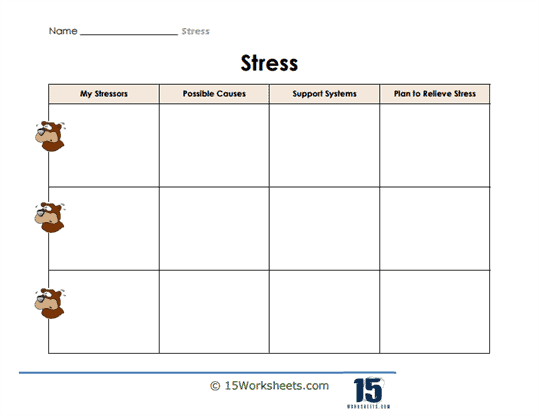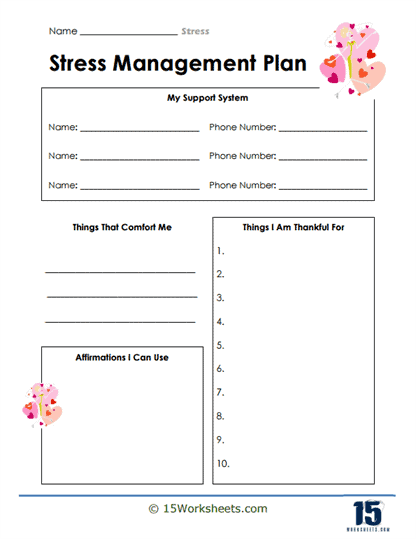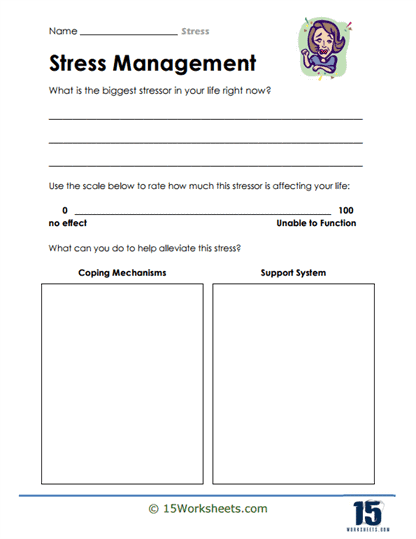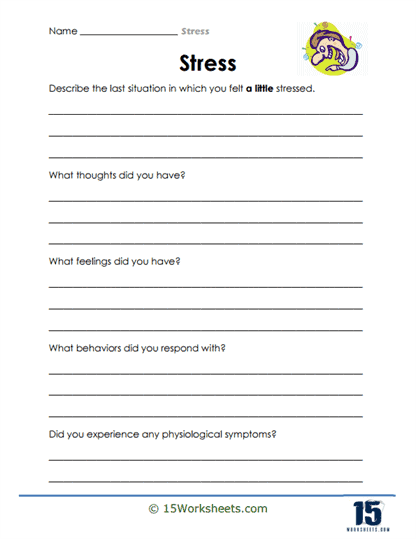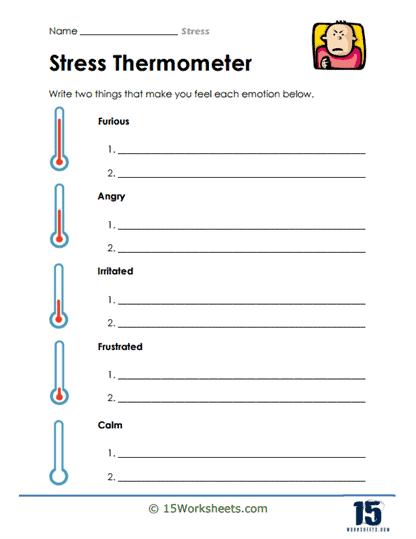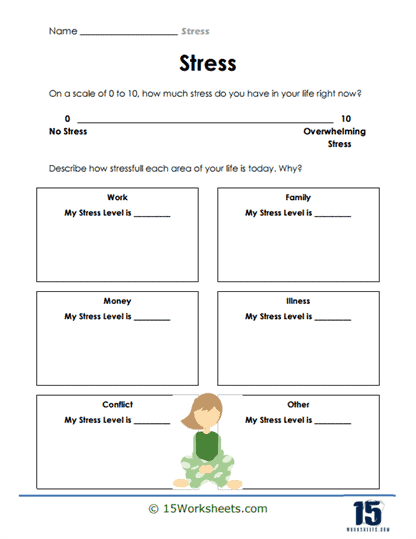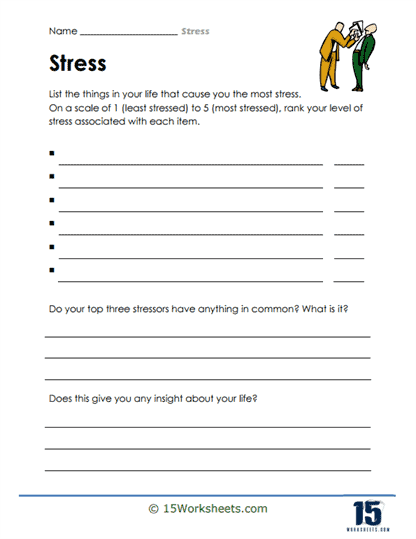Stress Worksheets
All About These 15 Worksheets
These worksheets help individuals, particularly students, teachers, homeschoolers, and tutors, better understand, manage, and cope with stress. These worksheets serve as structured guides for reflecting on stressors in different areas of life, exploring the effects stress has on one’s body and mind, and identifying effective coping mechanisms. They are often used in educational settings, therapy, or personal development to support mental health and emotional well-being.
For students, stress worksheets help them recognize stress from different aspects of their lives, such as school, social situations, family, and extracurricular activities. They encourage students to verbalize their stress triggers and think about healthy ways to manage them, offering a chance to develop emotional intelligence and coping skills at an early age. Teachers can use these worksheets to integrate mental health discussions into their classroom curriculum, fostering a supportive environment for students to openly discuss their concerns. The worksheets act as an icebreaker for these conversations and help students pinpoint the specific stressors they might not have been aware of.
Types of Exercises
Identifying Stressors – Many of the worksheets begin with asking individuals to list or recognize their stressors. This could include different domains of life, such as “At Home,” “At School,” “With Friends,” “In Community,” and “Specific Situations.” These segments help users break down and categorize their stress sources, making the challenges seem more manageable by focusing on one area at a time. By isolating these specific areas, individuals can better understand which aspects of their life contribute most to their stress and target them for improvement.
Coping Mechanisms – Another key feature is identifying coping strategies. Worksheets often provide a checklist of potential strategies, such as exercise, journaling, meditation, talking to friends, taking walks, and more. This allows individuals to reflect on what has worked for them in the past and explore new methods for handling stress in healthy ways. It also empowers users to take control over their stress by experimenting with different techniques, creating a sense of agency over their emotional well-being.
Changes During Stress – Many worksheets prompt individuals to recognize how their bodies, thoughts, and behaviors change when they are stressed. For example, users might reflect on physical signs like headaches or tension, thoughts of worry or frustration, and behavioral changes such as irritability or withdrawal. This reflection helps users understand the full impact of stress on their lives. Recognizing these patterns early can serve as a warning system, helping individuals intervene before stress becomes overwhelming or debilitating.
Action Plans and Goals – A vital aspect of these worksheets is the development of action plans. They often include sections where individuals can outline specific steps they will take to manage stress, including timelines and the coping strategies they plan to implement. This turns reflection into actionable solutions. By providing clear goals and a structured approach, these plans give users a roadmap to follow when they are feeling stressed, which increases their chances of success.
Support Systems – Some worksheets emphasize the importance of social support. They include sections where individuals can list the people in their support network, like family, friends, or teachers, and how they can rely on these individuals during stressful times. This highlights the role of community in stress management. Building strong support systems also reminds individuals that they are not alone in their struggles, which can significantly reduce feelings of isolation that often accompany stress.
Positive Affirmations and Gratitude – Several worksheets encourage individuals to focus on things that bring comfort or joy and list affirmations they can use to stay positive. A gratitude section often helps reframe the mind, moving from focusing solely on stress to recognizing positive elements in life. Shifting focus toward positivity and gratitude can help counterbalance negative thoughts and provide mental relief, fostering resilience against future stressors.
Ranking Stress – A few of the worksheets you provided include exercises where users can rank their stress levels for various situations or stressors on a scale, which helps individuals prioritize which stressors are most severe and need immediate attention. This ranking system provides a clearer picture of which stressors are impacting their lives the most, allowing for targeted efforts in reducing or managing these high-priority areas.
Physical and Emotional Awareness – Some exercises focus on building awareness of the body’s signals under stress. These can include recognizing when the body is tensed, when thoughts are racing, or when emotions feel overwhelming. This mindfulness exercise teaches individuals to listen to their bodies and intervene before stress escalates. Enhanced body awareness can lead to earlier and more effective use of coping strategies, preventing the buildup of chronic stress.
Goal Setting and Problem Solving – Many worksheets combine stress awareness with problem-solving. These sections guide individuals through the process of identifying their biggest stressors and brainstorming solutions. They may ask users to reflect on what resources they have available or need to acquire to tackle their stress. This fosters a proactive mindset, encouraging individuals to take practical steps toward addressing their stressors rather than feeling helpless or reactive in stressful situations.
Reflections on Success – There are also sections that ask users to reflect on coping strategies they have tried in the past. They might think about what has worked for them before and why, helping to refine their stress-management techniques for the future. Reflecting on past successes reinforces confidence in one’s ability to manage stress and encourages the repetition of effective strategies in future stressful situations.
Helping Students Handle Stress Better
Helping students deal with stress is crucial for their well-being and academic success. One of the most important first steps is teaching students to recognize the signs of stress. Many children and adolescents may not fully understand how stress manifests in their minds and bodies. By discussing common physical symptoms like headaches, fatigue, and stomachaches, as well as emotional indicators such as irritability, anxiety, and difficulty concentrating, educators can help students become more aware of their stress levels. This awareness enables students to identify when they are feeling overwhelmed and need to take action.
Once students can recognize their stress, the next step is teaching them coping strategies. Introducing practical techniques like deep breathing, mindfulness exercises, and progressive muscle relaxation can provide immediate relief. Simple breathing exercises, for example, can be taught in just a few minutes and can be used discreetly in almost any situation. Encouraging students to practice these techniques regularly, not just during moments of stress, helps build their resilience and gives them tools to manage their emotions proactively. Incorporating short mindfulness breaks into the school day can also be effective in maintaining a calm learning environment.
In addition to coping strategies, promoting healthy lifestyle habits is vital in managing stress. Teaching students the importance of regular exercise, a balanced diet, and adequate sleep can significantly impact their ability to handle stress. Exercise releases endorphins, which are natural mood lifters, and can help burn off the energy caused by anxiety. Encouraging students to engage in physical activity, whether through organized sports or simple outdoor play, can reduce stress. Similarly, helping students understand the connection between nutrition, sleep, and emotional well-being can foster healthier habits that support stress management.
Another essential aspect of helping students deal with stress is fostering a supportive and open classroom environment. Educators can create a safe space for students to talk about their feelings without fear of judgment. Regular check-ins, where students can share their thoughts and concerns, promote emotional expression and can help prevent stress from building up. Group activities that focus on teamwork, social bonding, and peer support can also reduce feelings of isolation, which often contribute to stress. Ensuring that students feel heard and valued can go a long way in easing their emotional burdens.
Teaching students time management and organizational skills can greatly reduce the academic stress they often face. Many students feel overwhelmed by assignments and tests, leading to procrastination and more stress. Educators can help by breaking down larger tasks into manageable steps, teaching students how to prioritize their work, and setting realistic deadlines. Providing tools like planners or checklists can also help students stay organized and reduce anxiety about schoolwork. By teaching these skills, students learn to take control of their responsibilities, which increases their confidence and decreases their stress levels.

